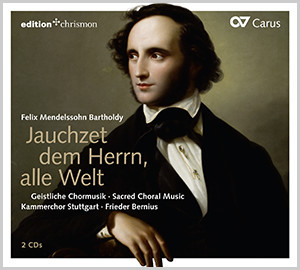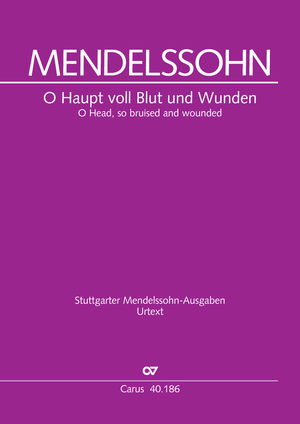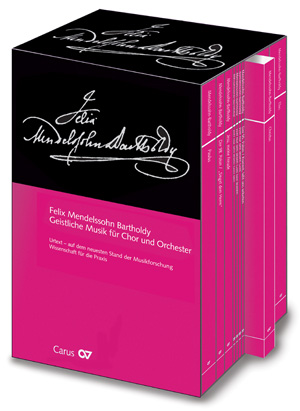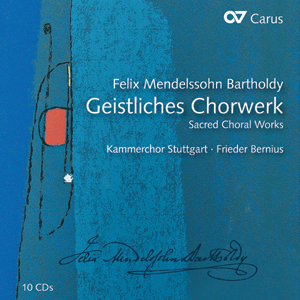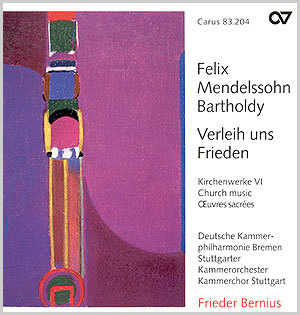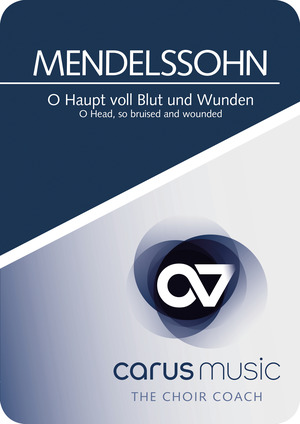
Cette cantate chorale est probablement inspirée par la représentation de la Passion selon saint Matthieu de Bach par Mendelssohn. Les motifs du chœur d’introduction sont certes connus grâce au choral, mais ce mouvement présente de nombreux défis : si la première entrée concerne encore le même motif mélodique ("O Haupt…"), celui-ci se superpose au deuxième vers du choral dès la deuxième entrée pour former ainsi des harmonies inattendues. Mendelssohn écrit à sa sœur : "Je me réjouis pour cette pièce dont personne ne saura si elle est en do mineur ou en mi bémol majeur […]" il est d’autant plus important de savoir où va sa propre partie et de bien placer les notes.
La Musique Chorale. Partout. A tout moment.
À la maison et en déplacement : désormais, vous aurez toujours vos œuvres chorales avec vous pour les travailler! Avec carus music, l’application pour choristes, vous pouvez écouter votre partition avec un excellent enregistrement sur votre smartphone ou tablette, et facilement travailler votre propre partie avec un coach. Avec carus music, votre préparation pour le concert est facile, efficace et agréable!
Interprètes: Michael Volle (basso) – Kammerchor Stuttgart, Stuttgarter Kammerorchester – Frieder Bernius
Sommaire
-
Compositeur
Felix Mendelssohn Bartholdy
| 1809-1847
-
Parolier/Librettiste
Paul Gerhardt
| 1607-1676Paul Gerhardt wurde am 12. März 1607 in Gräfenhainichen bei Wittenberg geboren. Nach dem Besuch der Fürstenschule in Grimma, einer der Eliteschulen des Kurfürstentums Sachsen, begann er 1628 sein Theologie-Studium in Wittenberg. Dieser Ort – Ursprung der lutherischen Bewegung – war prägend für sein weiteres Leben. Hier erhielt Gerhardt die theologische Bildung, die Grundlage war für seine spätere Tätigkeit als Pfarrer und Textdichter. Nach seinem Studium arbeitete er als Hauslehrer und wurde 1657 Diakonus an St. Nikolai in Berlin – die nächste wichtige Station. Durch Gerhardts enge Zusammenarbeit unter anderem mit Johann Crüger und dessen Nachfolger Johann Georg Ebeling entstand ein wichtiger intellektueller und künstlerischer Kreis in Berlin. Ebeling war es auch, der eine erste vollständige Gerhardt-Ausgabe edierte: Pauli Gerhardi Geistliche Andachten (1666/67). Darin enthalten sind 120 seiner später insgesamt 137 Lieder. Allein schon aufgrund der Vielzahl seiner Liedtexte stellt Gerhardt den wichtigsten evangelischen Textdichter nach Luther dar. Plus d'information sur la personne
-
Chœur
Kammerchor Stuttgart
The Kammerchor Stuttgart is regarded as one of the best ensembles of its kind. Over its fifty-year existence, Frieder Bernius has developed the choir into an exceptional ensemble acclaimed by audiences and press alike. This has led to invitations for the choir to perform at all the important European festivals. In Germany the chamber choir performs at festivals and in concert halls in repertoire ranging from the 17th to the 21st century. Frieder Bernius and his ensemble have received numerous accolades for their contribution to new music. The Kammerchor Stuttgart has made over 80 CDs and LPs, numerous of which have been awarded international recording prizes (including the Edison award, Diapason d’or, Gramophone Choice, Classical Internet Award, International Classical Music Award, and German Record Critics’ Award prizes). The International Federation for Choral Music has invited the ensemble to sing at the 1st, 4th and 10th World Symposia on Choral Music in Vienna, Sydney and Seoul. Regular tours of North America and Asia since 1988 and a South America tour reflect the Kammerchor Stuttgart’s international reputation. Since 1984 the top ensemble has also been invited to Israel biennially. Plus d'information sur la personne
-
Ensemble
Stuttgarter Kammerorchester
Founded in 1945, the Stuttgarter Kammerorchester is the oldest and most renowned ensemble of its kind and for over 65 years it has occupied an outstanding position in international orchestra culture. Michael Hofstetter has been the conductor of this ensemble since September 2006. The orchestra had already earned its excellent reputation under its founder and long-time director, Karl Münchinger. Through a completely new and exemplary style of interpretation of the works of Johann Sebastian Bach the Stuttgarter Kammerorchester became a pathfinder in the field of historical performance practice. Dennis Russell Davies, its principal conductor, from 1995 to 2006, expanded the repertoire of the orchestral, especially with works from 20th century. In 2008 the orchestra was awarded the European Chamber Music Award by the European Foundation for Culture. Plus d'information sur la personne
-
Chef d'orchestre
Frieder Bernius
| 1947Frieder Bernius’s work has earned great worldwide recognition. He is in demand internationally as a conductor and as a teacher. His principal artistic collaborators are the ensembles he founded himself, the Kammerchor Stuttgart, the Barockorchester Stuttgart, the Hofkapelle Stuttgart and the Klassische Philharmonie Stuttgart. As a guest conductor, he has collaborated repeatedly with, for example, the SWR Vokalensemble Stuttgart, the Deutsche Kammerphilharmonie Bremen, the Stuttgarter Kammerorchester and the Streicherakademie Bozen. Great stylistic versatility is Frieder Bernius’s hallmark. Whether he conducts vocal works by Monteverdi, Bach, Händel, Mozart, Beethoven, Fauré and Ligeti, stage music by Mendelssohn or symphonies by Haydn, Burgmüller and Schubert, his work always aims for a sound that is at once unmistakably personal and at the same time oriented towards the original period sound ideal. He devotes himself equally to the rediscovery of 18th century operas and to first performances of contemporary compositions. He is particularly interested in the musical history of southwestern Germany. Carus-Verlag has awarded Frieder Bernius a Golden CD for his complete recording of the sacred music of Felix Mendelssohn Bartholdy. The award was presented to him during the German Choir Festival in Stuttgart 2016. The sale of over 250,000 recordings, which has been acclaimed with a number of awards, has made a not insignificant contribution to what today is the obvious presence of Mendelssohn's complete œuvre in the concert repertoire. Plus d'information sur la personne
-
Solist - basse
Michael Volle
Questions fréquentes sur l'œuvre
 Il n'y a pas encore de questions et réponses concernant cette œuvre ou vous n'avez pas trouvé la réponse à votre question sur l'œuvre ? Cliquez ici et envoyez votre question spécifique à notre service clients.
Il n'y a pas encore de questions et réponses concernant cette œuvre ou vous n'avez pas trouvé la réponse à votre question sur l'œuvre ? Cliquez ici et envoyez votre question spécifique à notre service clients.


